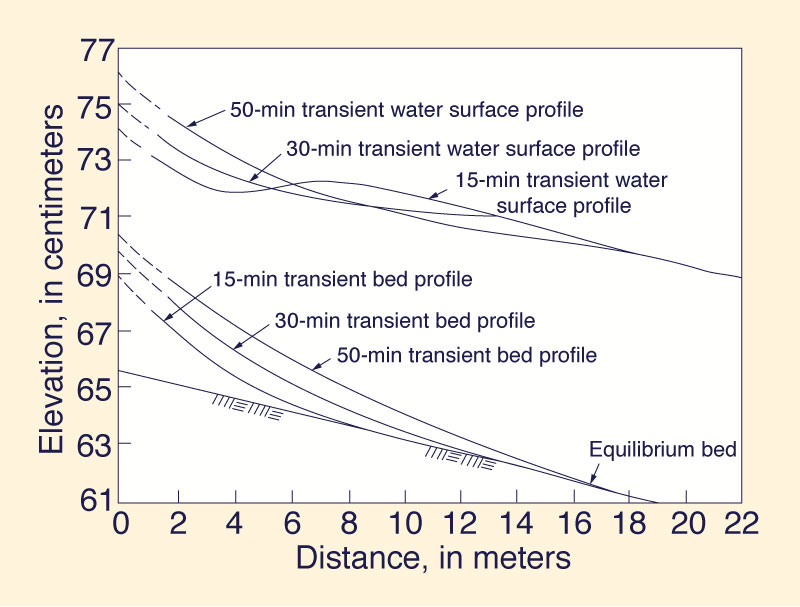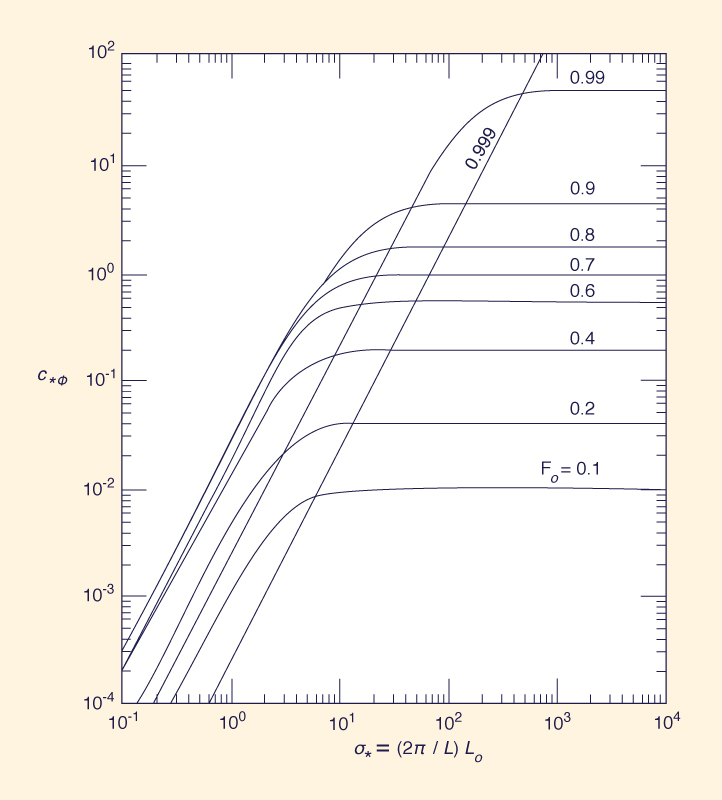1. INTRODUCTION There is an urgent need for improved analytical tools with which to assess the propagation of bed perturbations in alluvial channels. The importance of this endeavor may be seen readily in connection with the modeling of borrow pits in alluvial rivers and studies of long-term aggradation and degradation. Gradowczyk (2) and Cunge and Perdreau (1), among others, have researched the propagation of bed perturbations in its one-dimensional formulation. More recently, Ponce et al. (5) derived a formula for the celerity of bed perturbations as a function of hydraulic and bed material transport parameters. Soni et al. (6) carried out a series of flume experiments with the objective of studying flow characteristics in aggrading channels. Herein, the Soni et al. data is used to check the validity of the Ponce et al. theory. Given the limited extent of the data, the experimental check is regarded as preliminary, pending more detailed studies. Nevertheless, the results obtained are such that they warrant presentation in the hope of stimulating further research in this area of alluvial channel hydraulics. 2. THEORETICAL BACKGROUND Ponce et al. (1979) performed a linear stability analysis on the set of equations governing the flow of water and sediment in alluvial channels. Their analysis dealt with flows well below the critical state (say, F ≤ 0.6), for which the time scale of the bed transients is several orders of magnitude smaller than that of the water surface transients. Under these conditions, the quasi-steady assumption led to the following formula for the celerity of small bed perturbations:
in which Φ = bed material transport parameter (defined below); c*(Φ) = transport-normalized dimensionless celerity; and c*, σ*, Fo are the dimensionless celerity, dimensionless wave number, and Froude number of the unperturbed flow, respectively, defined as follows:
in which uo = unperturbed mean flow velocity; do = unperturbed flow depth; So = bed slope; The bed material transport function is modeled as a power of mean velocity, as follows:
in which gs = bed material transport rate per unit of channel width; u = mean flow velocity; and k and m = coefficient and exponent, respectively. When the bed material transport rate is expressed in terms of units of weight, the transport parameter Φ is given as follows:
in which p = porosity of the material in the channel bed; and ρs = mass density of solids. In certain cases, it is convenient to express the bed material transport rate in terms of volumetric units rather than weight units. This leads to the following equation for Φ:
It is further noticed that, for sufficiently large values of σ*, Eq. 1 reduces to:
making the value of c*(Φ) independent of σ* (Fig. 1). Given Eqs. 1, 2, and 8, the simplified expression for the celerity of bed perturbations is:
applicable for the case of a sufficiently large σ*. 3. EXPERIMENTAL VERIFICATION
The flume experiments of Soni et al. (6) were used to check the validity of Eq. 1 and its reduced version, Eq. 9. For this purpose, the data of Fig. 3 in Ref. 6 (shown here as Fig. 2), was used.
A typical porosity was assumed: p = 0.4, leading through Eq. 7 to a value of Φ = 0.02.
Given Fo = uo/(guo)1/2 = 0.45, σ* = 12 lies within the range for which the celerity is independent of σ*. Therefore, Eq. 9 is applicable, leading to ct = 0.0021 m/s, as the theoretical velocity of propagation of the bed transient shown in Fig. 2. In order to provide a meaningful comparison with the measured data, as depicted in this figure, an estimate of the velocity of propagation of this particular bed disturbance was made. The estimate consisted of measuring the distance along the channel between the 15- and 30-minute profiles, and between the 30- and 50-minute profiles, at five elevations positioned at 0.005-m intervals, starting at bed level. The average of 10 measurements was cm = 0.0029 m/s, which compares favorably with the theoretical celerity, ct = 0.0021 m/s, calculated by the Ponce et al. formula. The agreement is even closer if attention is drawn to the fact that the theoretical celerity is strictly valid only for small amplitude perturbations. Based on numerical experiments, Lopez-Garcia (3) has determined a correction factor α to be applied to the theoretical celerity in order to account for the finite transient amplitude. For Fo = 0.45, and taking the ratio of bed transient amplitude to the uniform flow depth, zo/do, as approximately 0.2 for the present case, the value of α according to Lopez-Garcia (3) is α = 1.2. Therefore, the theoretical celerity corrected for finite amplitude effects is ct = 0.0025 m/s. In view of the inherent variability in sediment transport mechanics and the difficulty of accurately measuring sediment motion, the results of the above comparison are indeed remarkable. Similarly, such agreement when comparing theoretical and measured bed transient celerities has been documented elsewhere (4). 4. SUMMARY AND CONCLUSIONS The applicability of a formula for the calculation of celerity of alluvial channel bed transients has been verified using data from flume experiments. The formula is easy to use, the celerity is expressed in terms of readily identified hydraulics and sediment transport parameters. The results obtained are encouraging, and show the promise of this approach in the qualitative analysis of unsteady alluvial channel hydraulics. The need for additional research in this area is recognized. REFERENCES
NOTATION
The following symbols are used in this paper:
c = celerity of bed perturbations;
cm = measured celerity;
ct = theoretical celerity;
c* = dimensionless celerity;
do = unperturbed flow depth;
F = Froude number of unperturbed flow, Eq. 4;
g = acceleration of gravity;
gt = bed material transport rate, per unit of channel width;
k = coefficient, in Eq. 5;
L = characteristic length of perturbation;
Lo = reference channel length, in Eq. 3;
m = exponent, in Eq. 5;
p = porosity of the material forming the channel bed;
So = bed slope;
u = mean flow velocity;
uo = mean velocity of the unperturbed flow;
zo/do = ratio of bed transient amplitude to unperturbed flow deph;
α = correction factor to the theoretical transient celerity in order to account for finite amplitude;
π = 3.1416;
ρs = mass density of solids;
σ* = dimensionless wave number; and
Φ = bed material transport parameter, Eqs. 5 or 6.
|
| 221013 |
| Documents in Portable Document Format (PDF) require Adobe Acrobat Reader 5.0 or higher to view; download Adobe Acrobat Reader. |

